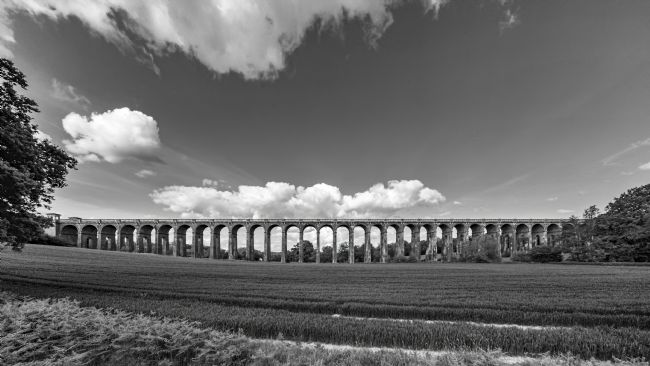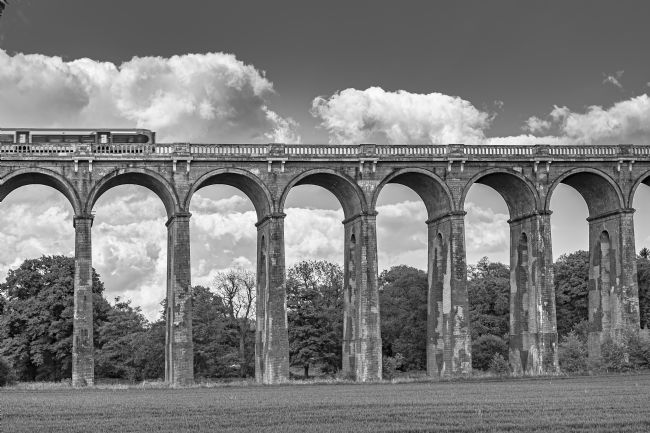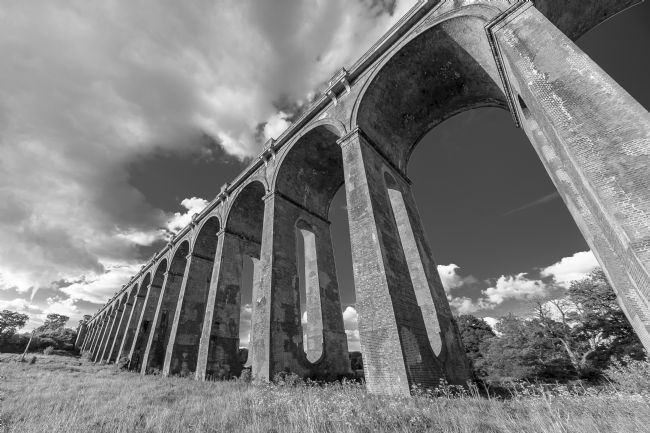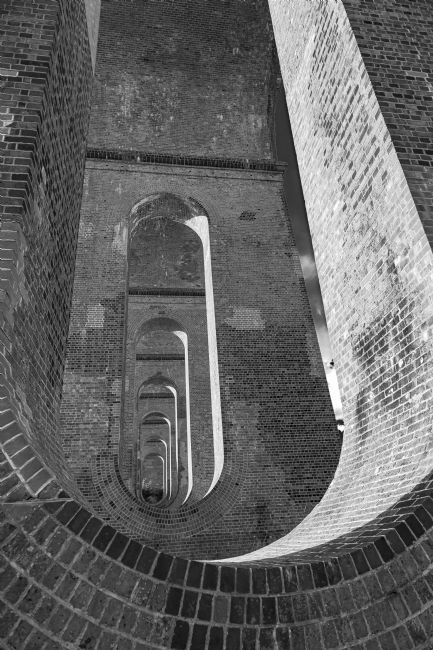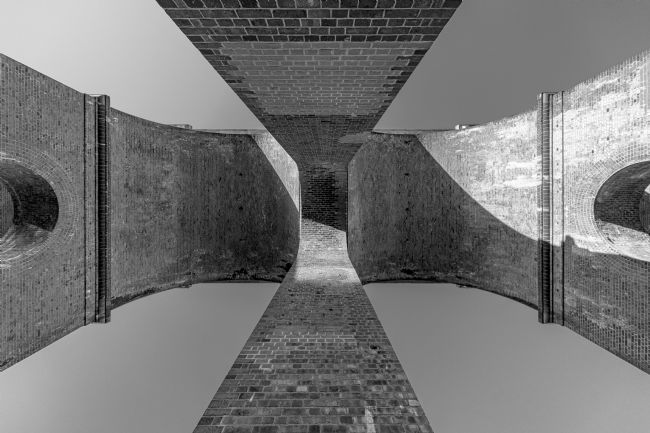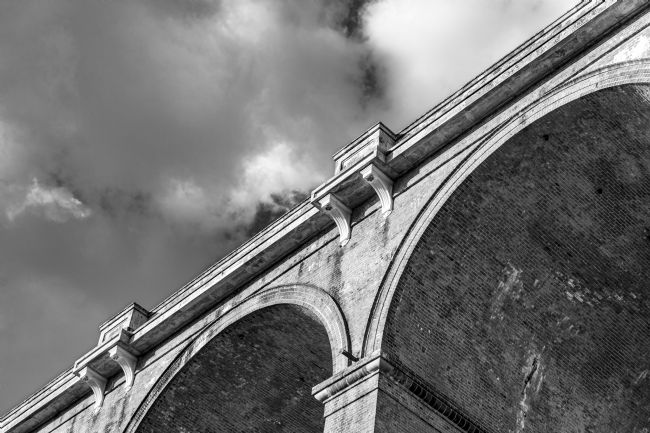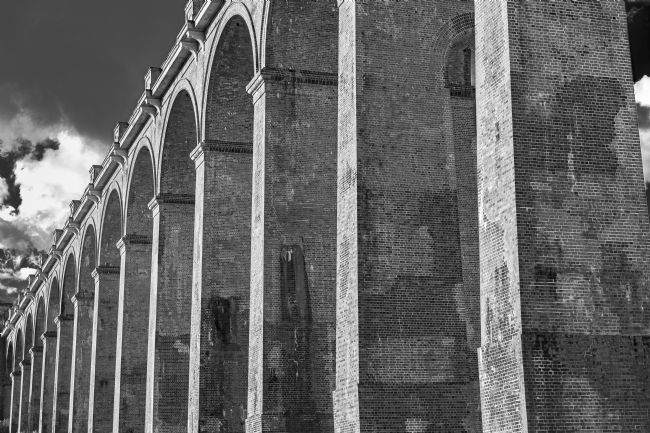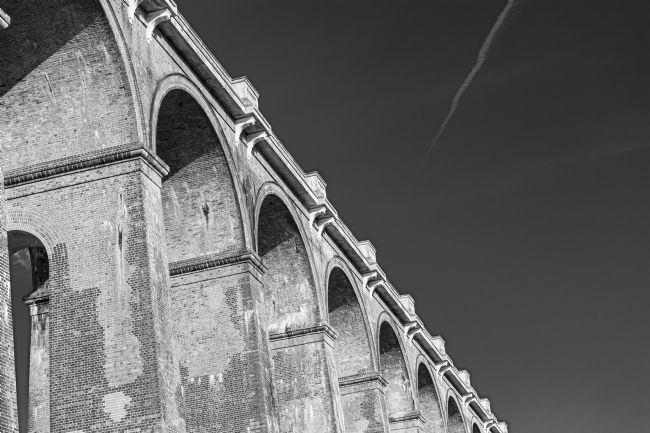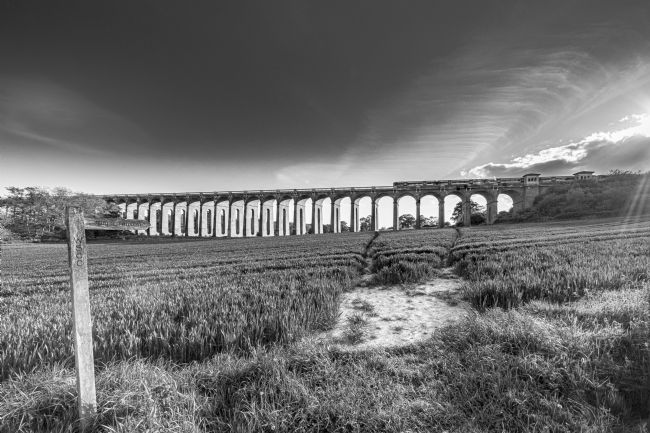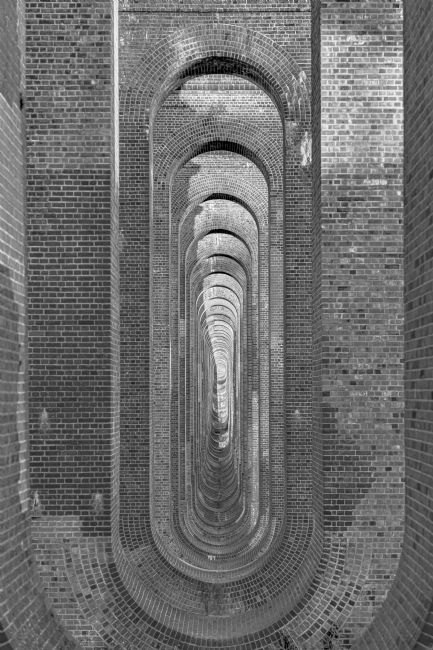The Ouse Valley Viaduct (Balcombe Viaduct)
-
Artists
-
Andrew King
-
The Ouse Valley Viaduct (Balcombe Viaduct)
-
(0)
The London to Brighton Railway was arguably the world's first line constructed largely or completely for passenger travel. The Ouse Valley represented a significant obstacle on the most direct route, and it was decided to cross it using this beautiful 37 arch, 500m long, 30m high viaduct. The structure was built between 1839 and 1842, and is said to have used 11 million Dutch bricks, brought up the river from Newhaven.
The Ouse Valley Viaduct (also called the Balcombe Viaduct) is one of the highlights of the line - whether seen from the minor road between Balcombe and Haywards Heath, from the footpaths that run through the valley, or, when travelling by train, you have the sensation that you are suddenly flying over the most beautiful, and quintessentially Southern English landscape.
I love this viaduct, as may be visible, and have photographed it many times. I hope these studies capture something of the unique strength and grace of this Victorian marvel.
The London to Brighton Railway was arguably the world's first line constructed largely or completely for passenger travel. The Ouse Valley represented a significant obstacle on the most direct route, and it was decided to cross it using this beautiful 37 arch, 500m long, 30m high viaduct. The structure was built between 1839 and 1842, and is said to have used 11 million Dutch bricks, brought up the river from Newhaven.
The Ouse Valley Viaduct (also called the Balcombe Viaduct) is one of the highlights of the line - whether seen from the minor road between Balcombe and Haywards Heath, from the footpaths that run through the valley, or, when travelling by train, you have the sensation that you are suddenly flying over the most beautiful, and quintessentially Southern English landscape.
I love this viaduct, as may be visible, and have photographed it many times. I hope these studies capture something of the unique strength and grace of this Victorian marvel.
The London to Brighton Railway was arguably the world's first line constructed largely or completely for passenger travel. The Ouse Valley represented a significant obstacle on the most direct route, and it was decided to cross it using this beautiful 37 arch, 500m long, 30m high viaduct. The structure was built between 1839 and 1842, and is said to have used 11 million Dutch bricks, brought up the river from Newhaven.
The Ouse Valley Viaduct (also called the Balcombe Viaduct) is one of the highlights of the line - whether seen from the minor road between Balcombe and Haywards Heath, from the footpaths that run through the valley, or, when travelling by train, you have the sensation that you are suddenly flying over the most beautiful, and quintessentially Southern English landscape.
I love this viaduct, as may be visible, and have photographed it many times. I hope these studies capture something of the unique strength and grace of this Victorian marvel.
The London to Brighton Railway was arguably the world's first line constructed largely or completely for passenger travel. The Ouse Valley represented a significant obstacle on the most direct route, and it was decided to cross it using this beautiful 37 arch, 500m long, 30m high viaduct. The structure was built between 1839 and 1842, and is said to have used 11 million Dutch bricks, brought up the river from Newhaven.
The Ouse Valley Viaduct (also called the Balcombe Viaduct) is one of the highlights of the line - whether seen from the minor road between Balcombe and Haywards Heath, from the footpaths that run through the valley, or, when travelling by train, you have the sensation that you are suddenly flying over the most beautiful, and quintessentially Southern English landscape.
I love this viaduct, as may be visible, and have photographed it many times. I hope these studies capture something of the unique strength and grace of this Victorian marvel.
The London to Brighton Railway was arguably the world's first line constructed largely or completely for passenger travel. The Ouse Valley represented a significant obstacle on the most direct route, and it was decided to cross it using this beautiful 37 arch, 500m long, 30m high viaduct. The structure was built between 1839 and 1842, and is said to have used 11 million Dutch bricks, brought up the river from Newhaven.
The Ouse Valley Viaduct (also called the Balcombe Viaduct) is one of the highlights of the line - whether seen from the minor road between Balcombe and Haywards Heath, from the footpaths that run through the valley, or, when travelling by train, you have the sensation that you are suddenly flying over the most beautiful, and quintessentially Southern English landscape.
I love this viaduct, as may be visible, and have photographed it many times. I hope these studies capture something of the unique strength and grace of this Victorian marvel.
The London to Brighton Railway was arguably the world's first line constructed largely or completely for passenger travel. The Ouse Valley represented a significant obstacle on the most direct route, and it was decided to cross it using this beautiful 37 arch, 500m long, 30m high viaduct. The structure was built between 1839 and 1842, and is said to have used 11 million Dutch bricks, brought up the river from Newhaven.
The Ouse Valley Viaduct (also called the Balcombe Viaduct) is one of the highlights of the line - whether seen from the minor road between Balcombe and Haywards Heath, from the footpaths that run through the valley, or, when travelling by train, you have the sensation that you are suddenly flying over the most beautiful, and quintessentially Southern English landscape.
I love this viaduct, as may be visible, and have photographed it many times. I hope these studies capture something of the unique strength and grace of this Victorian marvel.
The London to Brighton Railway was arguably the world's first line constructed largely or completely for passenger travel. The Ouse Valley represented a significant obstacle on the most direct route, and it was decided to cross it using this beautiful 37 arch, 500m long, 30m high viaduct. The structure was built between 1839 and 1842, and is said to have used 11 million Dutch bricks, brought up the river from Newhaven.
The Ouse Valley Viaduct (also called the Balcombe Viaduct) is one of the highlights of the line - whether seen from the minor road between Balcombe and Haywards Heath, from the footpaths that run through the valley, or, when travelling by train, you have the sensation that you are suddenly flying over the most beautiful, and quintessentially Southern English landscape.
I love this viaduct, as may be visible, and have photographed it many times. I hope these studies capture something of the unique strength and grace of this Victorian marvel.
The London to Brighton Railway was arguably the world's first line constructed largely or completely for passenger travel. The Ouse Valley represented a significant obstacle on the most direct route, and it was decided to cross it using this beautiful 37 arch, 500m long, 30m high viaduct. The structure was built between 1839 and 1842, and is said to have used 11 million Dutch bricks, brought up the river from Newhaven.
The Ouse Valley Viaduct (also called the Balcombe Viaduct) is one of the highlights of the line - whether seen from the minor road between Balcombe and Haywards Heath, from the footpaths that run through the valley, or, when travelling by train, you have the sensation that you are suddenly flying over the most beautiful, and quintessentially Southern English landscape.
I love this viaduct, as may be visible, and have photographed it many times. I hope these studies capture something of the unique strength and grace of this Victorian marvel.
The London to Brighton Railway was arguably the world's first line constructed largely or completely for passenger travel. The Ouse Valley represented a significant obstacle on the most direct route, and it was decided to cross it using this beautiful 37 arch, 500m long, 30m high viaduct. The structure was built between 1839 and 1842, and is said to have used 11 million Dutch bricks, brought up the river from Newhaven.
The Ouse Valley Viaduct (also called the Balcombe Viaduct) is one of the highlights of the line - whether seen from the minor road between Balcombe and Haywards Heath, from the footpaths that run through the valley, or, when travelling by train, you have the sensation that you are suddenly flying over the most beautiful, and quintessentially Southern English landscape.
I love this viaduct, as may be visible, and have photographed it many times. I hope these studies capture something of the unique strength and grace of this Victorian marvel.
The London to Brighton Railway was arguably the world's first line constructed largely or completely for passenger travel. The Ouse Valley represented a significant obstacle on the most direct route, and it was decided to cross it using this beautiful 37 arch, 500m long, 30m high viaduct. The structure was built between 1839 and 1842, and is said to have used 11 million Dutch bricks, brought up the river from Newhaven.
The Ouse Valley Viaduct (also called the Balcombe Viaduct) is one of the highlights of the line - whether seen from the minor road between Balcombe and Haywards Heath, from the footpaths that run through the valley, or, when travelling by train, you have the sensation that you are suddenly flying over the most beautiful, and quintessentially Southern English landscape.
I love this viaduct, as may be visible, and have photographed it many times. I hope these studies capture something of the unique strength and grace of this Victorian marvel.
The London to Brighton Railway was arguably the world's first line constructed largely or completely for passenger travel. The Ouse Valley represented a significant obstacle on the most direct route, and it was decided to cross it using this beautiful 37 arch, 500m long, 30m high viaduct. The structure was built between 1839 and 1842, and is said to have used 11 million Dutch bricks, brought up the river from Newhaven.
The Ouse Valley Viaduct (also called the Balcombe Viaduct) is one of the highlights of the line - whether seen from the minor road between Balcombe and Haywards Heath, from the footpaths that run through the valley, or, when travelling by train, you have the sensation that you are suddenly flying over the most beautiful, and quintessentially Southern English landscape.
I love this viaduct, as may be visible, and have photographed it many times. I hope these studies capture something of the unique strength and grace of this Victorian marvel.
The London to Brighton Railway was arguably the world's first line constructed largely or completely for passenger travel. The Ouse Valley represented a significant obstacle on the most direct route, and it was decided to cross it using this beautiful 37 arch, 500m long, 30m high viaduct. The structure was built between 1839 and 1842, and is said to have used 11 million Dutch bricks, brought up the river from Newhaven.
The Ouse Valley Viaduct (also called the Balcombe Viaduct) is one of the highlights of the line - whether seen from the minor road between Balcombe and Haywards Heath, from the footpaths that run through the valley, or, when travelling by train, you have the sensation that you are suddenly flying over the most beautiful, and quintessentially Southern English landscape.
I love this viaduct, as may be visible, and have photographed it many times. I hope these studies capture something of the unique strength and grace of this Victorian marvel.
